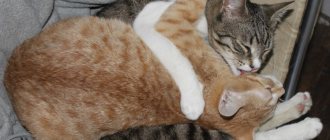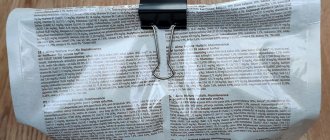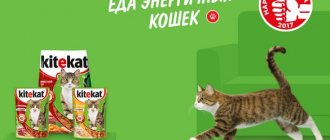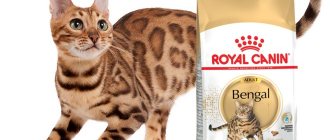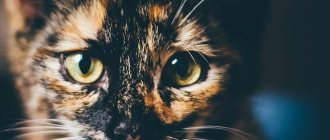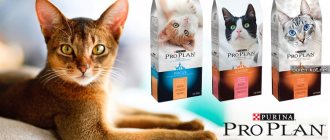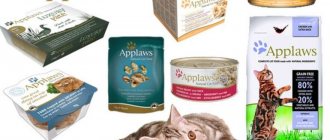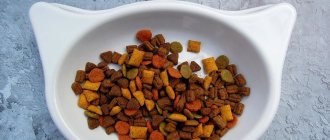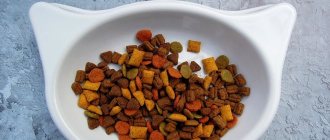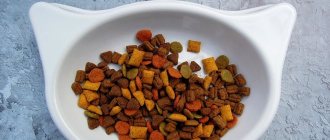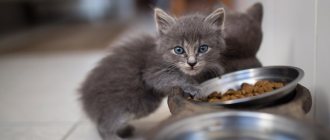There may be several reasons for decreased appetite in cats:
- physiological, related to the natural functioning of the body;
- pathological (medical) related to health status;
- reasons related to feed quality;
- reasons related to the behavior of the owners.
Let's talk in more detail about each group.
Temperature
In the wild, cats eat their prey while it is warm. Indoor cats don't like cold wet food either. Also, the consistency and flavor changes after being refrigerated.
A cat may well agree to eat food from a freshly opened pack, but refuse food from the refrigerator.
Before cooling, the gravy of the canned food or pouch is a nice, tasty liquid that coats all the pieces. The cat has a desire to eat the entire portion.
When you take wet food out of the refrigerator, the gravy becomes thick and congealed. In addition, the pleasant aroma disappears. This type of food is not attractive to the cat.
Tip 1: Heat the food until the liquid consistency and stronger aroma returns
Tip 2: Store the remaining food in an open package not in the refrigerator, but in a bowl of cold water. To keep the water useful longer, add a couple of pieces of ice to the bowl. This will keep the food fresh throughout the day without losing its texture or flavor.
Physiological causes of decreased appetite in cats
Cats are characterized by instability of appetite, this is due to the fact that they are predators. In their natural habitat, cats do not have the opportunity to receive food in the same amount every day. Today she was lucky to catch three mice and one bird, and tomorrow only one mouse. For our pets, food is always available in the right quantity, but sometimes they can relieve their body for a day and eat a little less food than usual without harm to their health.
Another factor influencing appetite is the sexual activity of animals. Uncastrated representatives of the cat tribe, in search of love, sometimes completely forget about food, and doctors will not help here. If a pet is losing weight, and the owner does not consider it necessary to castrate it, then he must take care of the calorie content of the diet so that the animal receives the required amount of energy in small portions.
To understand that a cat has become poor at eating food precisely for a physiological reason, you need to carefully observe it throughout the day. If she continues to drink water, is active, sociable, has a clear look, and her natural functions remain normal, then there is no need to worry. If fasting continues for more than a day while feeling well, or you notice your cat is feeling unwell already on the first day, you should immediately show her to a veterinarian - the sooner treatment begins, the easier and more effective it will be.
Tired of food
Cats, like people, can become bored with the same food over a long period of time. If your cat has been eating wet food for more than a year, it is likely that she may have become bored with it.
Tip 1: Do not give your cat the usual wet food for a couple of days or more. Perhaps after a break she will be happy to accept it.
Tip 2: Place a treat inside the wet food. The cat will eat the treat first and then move on to the main portion of food.
You can also enhance the taste with treats in the form of broths and gravies.
Tip 3: try choosing food from the same line, but with a different taste. Flavors typically offered include chicken, turkey, lamb, tuna, and beef.
Also experiment with the texture of the food: pates, pieces, shredded meat, etc.
You may need to consider other brands of food.
Tip 4: if your cat only receives wet food, then try adding dry food from the same line to the diet. This way you diversify the menu. Study the manufacturer's recommendations for the proportions and ratio of wet and dry diets.
If your pet is on a nutritional diet, be sure to consult with your veterinarian before making dietary changes.
You might be wondering: How to get a cat to eat medicated food?
Food quality as a cause of decreased appetite in cats
Sometimes it happens that a cat’s appetite worsens due to a change in the quality of food. The cat feels well, does not show symptoms of the disease or they have been excluded by the veterinarian, but the appetite is still reduced; the pet eats, but as if with reluctance, perhaps even asks for other food. In this case, you need to pay attention to the food that the cat eats.
First, check the expiration dates on the packaging and make sure that the food is not expired. Also analyze the storage conditions - if they are violated, the food may lose its taste and even deteriorate. It must be stored in a cool place, without access to light and air, in a tightly closed container so that it does not erode.
Re-read the ingredients on the food package and try to determine if it has changed. You can use the manufacturer’s websites or online pet stores to compare the information on them with the composition on the packaging. It happens that the manufacturer changes the formula of the food, adds new ingredients to the composition or excludes something from it, reduces or increases the amount of any ingredient - cats can react to such innovations, including with a decreased appetite.
It is also important to check the organoleptic properties of the food (smell, taste, color, shape of granules). If they are not the same as the product in the previous pack or are very different, contact the store where you made the purchase, the manufacturer or distributor and try to negotiate an exchange of food or a refund.
If your cat does not eat dry food well, you can try giving it soaked: pour a small amount of food into a bowl, add a little water to it, let it sit for a while (10-15 minutes) and offer it to the cat. Not all cats agree to eat dry food in this modified form, but there are some who like it. When feeding soaked dry food, the main thing is to follow safety rules: pour in as much food as the cat will eat at a time, and do not leave it in the bowl for a long time - in hot weather, bacteria will begin to multiply in it within half an hour, and such food will become dangerous to the cat's health.
If a cat does not eat wet food well, the algorithm of actions is the same as in the case of dry food: we check expiration dates, storage conditions, organoleptic properties, changes in composition. All these factors need to be analyzed and understood what could be the reason for the deterioration of appetite. Manufacturers usually have many different flavors in their wet food lines; you can offer your cat wet food with a different flavor and watch her appetite. But do not overdo it, so as not to develop pickiness in your pet.
To make wet food more attractive to your cat, you can warm it up to 35-40 degrees (but no more) and see if the cat's reaction to warm food changes. It is also extremely important not to leave canned food in the bowl for a long time: put in as much as the animal can eat in one meal, so that the food in the bowl does not dry out and so that pathogenic bacteria do not multiply in it.
The composition has changed
Sometimes the same wet food can vary in consistency and taste from batch to batch. Perhaps the manufacturer has changed the composition and formula of the product. Compare the ingredients on the old and new packaging. You can also contact the manufacturer and clarify the information. Even if you find out that the formula has not been changed, you cannot be absolutely sure.
If all your cats refuse to eat this food, then it is likely that the problem is due to the changed composition.
Perhaps the food has simply spoiled due to improper storage in a warehouse, store or at your home.
Pathological (medical) causes of decreased appetite in cats
Just like people, cats want to eat less or not at all when they are sick. There are many medical reasons for deterioration of appetite, including general and local infectious diseases, pathologies of individual internal organs (gastrointestinal tract, urinary system and others), poisoning, foreign body stuck in the gastrointestinal tract, diseases of the teeth and gums. In fact, any ailment, from very minor to very severe, can affect the appetite of a cat.
Only a veterinarian can determine the exact cause, but the owner’s task is to help him with this. Therefore, observe the cat, note all alarming symptoms, and also analyze living conditions: the presence of vaccinations, chronic diseases; could the cat have eaten something harmful to it, does it have access to indoor plants, household chemicals. Check the cat's toys for damage, and if there is a child in the house, then check his small toys to see if anything is missing or damaged. Perhaps the pet's appetite and general condition have worsened due to the ingestion of a foreign body.
After analyzing the situation and assuming that the cat is starving for medical reasons, do not delay a visit to the veterinary clinic. Remember that after 48 hours of complete fasting, irreversible changes occur in the cat's liver: the healthy tissue of this organ begins to be replaced by fatty tissue, a condition called fatty degeneration (lipidosis) of the liver. An organ affected by lipidosis can no longer fully perform its function. The disease can be prevented by not letting your cat go hungry for too long. Therefore, you need to see a doctor as quickly as possible, establish a diagnosis, begin treatment and improve nutrition.
Bowl not clean enough
There are often wet food residues left in the bowl. If washed irregularly, an unwanted odor appears. Cats are not only picky eaters, but also hypersensitive to smells.
If the food has been sitting out for too long or the bowl is dirty, it is likely that the cat will refuse to eat.
Try to wash the bowl regularly and thoroughly, without using strong-smelling detergents.
Opt for metal or ceramic bowls as they are easier to clean. Cheap plastic accumulates bacteria and odor.
Owner behavior as a cause of deterioration in appetite in cats
Someone may be surprised by this formulation of the question, but sometimes a deterioration in appetite in cats or pickiness in food is a consequence of the behavior of the owners. If, at the first request of a cat, they change the type or taste of food, at the first refusal of dry food they offer wet food, if they buy food with a questionable or inconsistent composition, the likelihood of whims increases. Animals begin to manipulate their owners in order to get what they want.
If the cat feels well and the quality of the food is fine, do not rush to make any changes to the diet on the first day, watch for purring. If the appetite remains poor, you can, of course, offer your cat food with a different flavor, but do not buy the entire pet store trying to find the right one, so as not to turn your pet into a picky eater.
Many owners, when their pet has a poor appetite, act on the principle of “knocking out a wedge with a wedge”, do not feed the cats for several days in a row and wait until they are so hungry that they eat what they should eat, in the opinion of the owners. There is a common expression that no one has ever died with a full bowl, but here it is important not to go to extremes. You can let your cat starve not as a punishment, but understanding its possible need for temporary fasting, but, as indicated in the section on medical reasons, do not allow your pet to starve for more than a day, and certainly do not contribute to this with your actions, do not deprive the cat of food for a long time in to awaken appetite.
Another simple, but not always obvious reason for poor appetite in cats can be banal overfeeding. The cat is full, so it doesn’t eat, and the owner thinks that the poor thing is starving and refuses food. Determine the daily amount of food required for your pet, pour food into the bowl not by eye, but according to the norm, and monitor how much the cat eats.
If the daily amount of food is not completely eaten, determine how much the cat is not eating; the amount of uneaten food within 20% of the daily norm is not a reason to panic. When a cat eats much less than it should normally, this is a reason to analyze all the above factors and take appropriate actions.
Whiskers sensitivity
A cat's whiskers are sensory receptors connected to their nervous system. Any movements or touches send signals to the brain.
Some cats don't like their whiskers getting dirty and clinging to the bowl.
When the whiskers touch the food and bowl too often, it results in an overload of sensory messages. The cat may become nervous and lose its appetite. This phenomenon is called “whisker fatigue.”
Here are the symptoms that your cat is experiencing “whisker fatigue”:
- walks around the bowl and meows
- refuses to eat from his own bowl
- trying to get food out of the bowl
- becomes aggressive with food when he takes it out of the bowl
Solution: a wide but shallow bowl that is comfortable for the cat.
Mixed feeding, lots of treats in the diet
This reason is one of the most common. The owner complains that the cat has stopped eating dry food, and he does everything possible to discourage his appetite: he treats him with food from his table, brings pates and pouches from the supermarket, buys special cat treats from pet stores. With this approach, the animal simply does not have time to get hungry.
Signs of a cat's appetite being spoiled due to your fault:
- the cat receives “sweets” every day, and they are offered in addition to the main diet.
- interest in dry food decreased when you started alternating it with wet food.
Solution
If you plan to continue feeding your animal dry food, leave only that and remove everything else (canned food, treats). As a rule, your appetite improves within a couple of days. It’s okay if during this period the cat is naughty and even hungry. The main thing is that he drinks enough.
The cat stopped eating dry food because he got sick
Most serious illnesses are accompanied by a decrease or complete loss of appetite. Therefore, if your pet refuses dry food, take a closer look to see if he has other alarming symptoms.
Signs:
- general malaise: the cat ceases to be interested in games, tries to hide in a secluded place;
- digestive problems: diarrhea, constipation, vomiting, retching;
- increased body temperature;
- pathological discharge from the eyes and nose;
- excessive shedding, itching, rash on the skin and mucous membranes;
- The cat stopped eating not only dry food, but also any other food.
The animal just doesn't want to eat
Satiety is one of the most harmless reasons for a four-legged pet’s refusal to eat ready-made food, which it usually eats with great pleasure. If there is a lot of food left in the bowl, the animal may need less food to be satisfied, so it is recommended to reduce the single dose of food. The remaining granules oxidize when exposed to oxygen and change the taste. In addition, after lying in a bowl, they become damp and become unsuitable for further use.
When determining the amount of feed required for a particular animal to be satisfied, its age and body weight must be taken into account. For the convenience of consumers, manufacturers of dry granules place information on the packaging about the amount of product cats need. Typically this data is presented in table form.
How to feed a cat if he doesn't eat
When a cat is healthy and feels comfortable living in a house with its owners, there is no reason to force it to eat. Sometimes a pet is so passionate about getting food that it begs for it even more often than it really needs it. Typically, such cats always have a variety of food in their bowl, which they do not even eat completely. Therefore, an animal in normal health will always be interested in getting more goodies, and there will be no reason to force it to eat food.
Causes of decreased appetite in cats
If a beloved domestic cat suddenly stops eating well or refuses to eat at all, this immediately alerts the owners. The reasons that a pet does not eat food can be different. The most common reason is that the cat is overfed and his body requires unloading. This is the most harmless reason, which usually does not bring with it any bad consequences. But most often, cats eat poorly due to weakness and malaise, a clogged nose (the animal cannot smell the food), and also due to stress. Stress can be caused by a sudden rearrangement of furniture, moving, or lack of attention to the animal.
A caring owner will immediately discover that something is wrong with the cat if he has not touched food for a whole day. When a cat does not eat for more than two days, this is an indicator of a serious illness that needs to be treated. The most unpleasant thing is when a pet refuses food and water completely. He may lose serious weight and become very weak. This cannot simply be left alone, which is why veterinary practice often resorts to force-feeding animals.
Force feeding
In this case, you cannot think that the cat will start eating on its own in a couple of days. Most likely, he will need serious help and should be seen by a doctor as soon as possible. The most important thing is to understand why the animal stopped eating, became lethargic, and lost interest in life.
It is important to carry out all the necessary studies and even an ultrasound of the abdomen, since refusal to eat can be caused by abdominal pain, dysfunction of organs, as well as abscesses in the oral cavity. Force feeding includes:
Special diets
The result of the examination allows the doctor to immediately prescribe proper nutrition, a diet that will need to be strictly followed. But if the cat already eats poorly, then specialized food is unlikely to be to his taste. If a very small kitten is sick, you will even have to wake him up specifically to feed him. Alternatively, you can try finger feeding your baby, but you need to do it carefully, do not push your finger down his throat, and be a little more patient. Then the kitten will lick the food itself.
It is worth knowing that a very small kitten, which is not yet six months old, will not live even a day without food. Therefore, along with patience, you need to be persistent if you want to help your baby survive. An adult cat can live for two days, but this is all relative, because there are different diseases, more complex and milder.
Syringe feeding
For syringe feeding, the doctor prescribes veterinary pates, which are well diluted with water. If the food is dry, it needs to be soaked only with boiled, warm water. Before you start feeding, the food itself also needs to be warmed up, because it is its warm state that increases the aroma and can entice the kitten to try it. To force-feed your pet through a syringe, you need to hold the kitten by the head and gradually introduce food with a syringe without a needle.
Feeding solid foods
You need to watch the cat for a while. If the body positively perceives the portion of food that it managed to inject by force through a syringe, then over time you can give it more. If the diet is not too strict, then you can switch to homemade food - semolina, warm broths, dairy products. If, after a couple of days of feeding, the cat still does not eat on its own, then you can also force-feed it, but use solid food for this.
You can use regular food for adult animals and kittens, but soak it a little in milk to make it easier to swallow. Suitable pieces of boneless fish, minced meat, soft pieces of white bread. To do this, you need to take the cat under your left hand, unclench its teeth, and push a small piece from the side with your right hand. Then help her clench her jaws - most likely the cat will swallow the food. You should never mix medications into food - the animal will hear a foreign smell, and this may further discourage it from eating.
In order for the cat to recover quickly and begin to eat on its own, it is advisable to accompany each meal with pleasant emotions - talk to it affectionately and stroke it. Then your pet’s health will improve faster.
Rules for switching to new food
When changing your usual diet, you need to be patient and consistent. You should not scold an animal or indulge it when it presses for pity. A sharp transition is harmful to health, so the new food needs to be mixed a little with the old one. On average, this takes 1-2 weeks.
Frequent product changes are harmful!
Frequently changing brands is fraught with problems with the gastrointestinal tract. To avoid diarrhea and constipation, veterinarians recommend sticking to a specific brand even on a therapeutic diet. This is not so difficult, since most manufacturers produce several lines that take into account the age and other characteristics of the animal.
Transition from straight
It's not safe to mix different types of foods, so don't be surprised by temporary bowel problems. In this case, this cannot be avoided, so be patient and adhere to the following scheme:
- 25% “drying” and 75% natural – 1-4 days;
- 50% of each type – 5-9 days;
- 75% “drying” and 25% natural – 9-14 days.
At the end of 2 weeks, pellets should make up 100% of the diet. For the first 4 days, you can soak them a little in water so that your pet is not scared off by the unusual consistency.
Switching from wet food
Feeding only wet canned food softens the gums, causing increased bleeding and premature tooth loss. For this reason, they should be combined with dry granules.
The principle of transition here is similar to the previous point. The only difference is that the final proportion must correspond to the instructions on the food packaging. There are detailed rules for feeding animals with 2 types of food.
Please note that increasing the amount of dry kibble will require a large amount of liquid to digest it. Make sure your pet drinks enough water and replace it with fresh water regularly.
Signal of malaise
Refusal of the usual food may indicate poor health of the animal and the development of a particular disease.
The danger of cheap food. For some time, the cat can be quite happy with its diet, regularly eating economy-class dry food. However, low-quality feeds laden with artificial additives have adverse effects, with response times ranging from a few hours to months or even years.
The cumulative negative impact imperceptibly destroys the animal’s body, causing disruptions in the functioning of organs and systems. In particular, cats that eat cheap dry food already at a young age suffer from kidney pathology, urolithiasis, gastritis, pancreatitis, allergic manifestations and skin problems. The worsening of the disease ultimately leads to poor health of the animal, accompanied by a refusal to eat.
Signs of the disease. Unfortunately, mustachioed striped animals are susceptible to a wide variety of diseases, including genetic pathologies, infections, helminthiases, metabolic disorders and all kinds of malfunctions of organs and systems. You can suspect something is wrong if a refusal to eat dry food is accompanied by:
- absolute loss of appetite and aversion to any type of food, including treats;
- increased body temperature;
- noticeable decrease in activity, lethargy and apathy;
- the desire to hide in a dark corner and stay there for a long time;
- drooling, vomiting and intestinal upset;
- copious discharge from the nose and eyes;
- unsteady gait, lack of coordination, convulsions;
- urinary retention, strong unpleasant odor of excreted urine, appearance of blood and pus in urine;
- severe difficulty breathing;
- swelling of the abdomen and limbs;
- the appearance of lumps, tumors and ulcers on the skin and body.
Prevention and treatment. To avoid health-related troubles, you must:
- Treat your favorite cats with suitable natural food or balanced premium and super-premium food that does not contain artificial colors or dangerous preservatives.
- Do not ignore even the most minor ailments of your pet, clearly monitoring his well-being.
- Have the contact details of a competent veterinarian at hand.
- If a particular pathology is detected, strictly follow the specialist’s recommendations, in particular diet and nutritional regimen.
Caring for your pet should be caring and feeding should be rational, which will ensure satisfactory health for many years.
How and what to feed a sick cat?
High-quality, nutritious nutrition plays a huge role in maintaining a cat’s health and attractive appearance. But it becomes even more important when the animal develops health problems.
During periods of poor health in a pet, the owner must pay special attention to its diet and ensure that the weakened body receives a sufficient amount of vitamins and nutrients. And during recovery, animals require more healthy, nutritious food than usual.
Often this pet’s eating behavior is a consequence of various diseases, especially those related to the gastrointestinal tract, as well as other health problems:
- 1. A foreign object in the throat or esophagus that the animal cannot remove on its own.
- 2. Serious body bruise.
- 3. Poisoning.
- 4. Stress.
If a cat does not eat anything, it must be shown to an experienced veterinarian, undergo an examination and pass all the prescribed tests: blood, urine, ultrasound.
If the animal’s portions have been reduced during illness, then there is no need to panic.
It is important to ensure that your cat drinks plenty of water. This will help avoid dangerous dehydration.
If the pet categorically refuses any food intake, then in this case you will need to be patient and look for ways that will help feed the animal and prevent a lack of nutrients in its body. Among them:
- 1. Warm food, heated to approximately 39 ° C, becomes more aromatic and attractive to the cat.
- 2. If for some reason an animal has problems with its sense of smell, you should put small pieces of treats on its lips.
- 3. Sick cats are much more willing to eat liquid foods than solid ones, and they should become the basis of the diet.
- 4. If it is difficult for an animal to get up to get to the feeding area, the best solution would be to give it food from your hand, while stroking and calming the pet.
Sometimes the animal becomes so weak that it is unable to move independently or chew food. In this case, the owner must assist him in eating. It is convenient to use a miniature syringe for this. A 2 ml product will be sufficient.
The tip of the syringe is cut off with a knife, and the edges are cleaned so that they are not sharp. The tube is filled with liquid food, after which the product is brought to the animal’s nose. This is necessary so that your pet can smell the treat.
As soon as the cat opens her mouth a little, slowly squeeze a small portion of food onto her tongue. If the animal does not do this on its own, you will have to slightly open its jaws with your fingers. Do not press too hard to avoid causing pain to your pet. Otherwise, the next time the feeding procedure will cause negative emotions in him.
